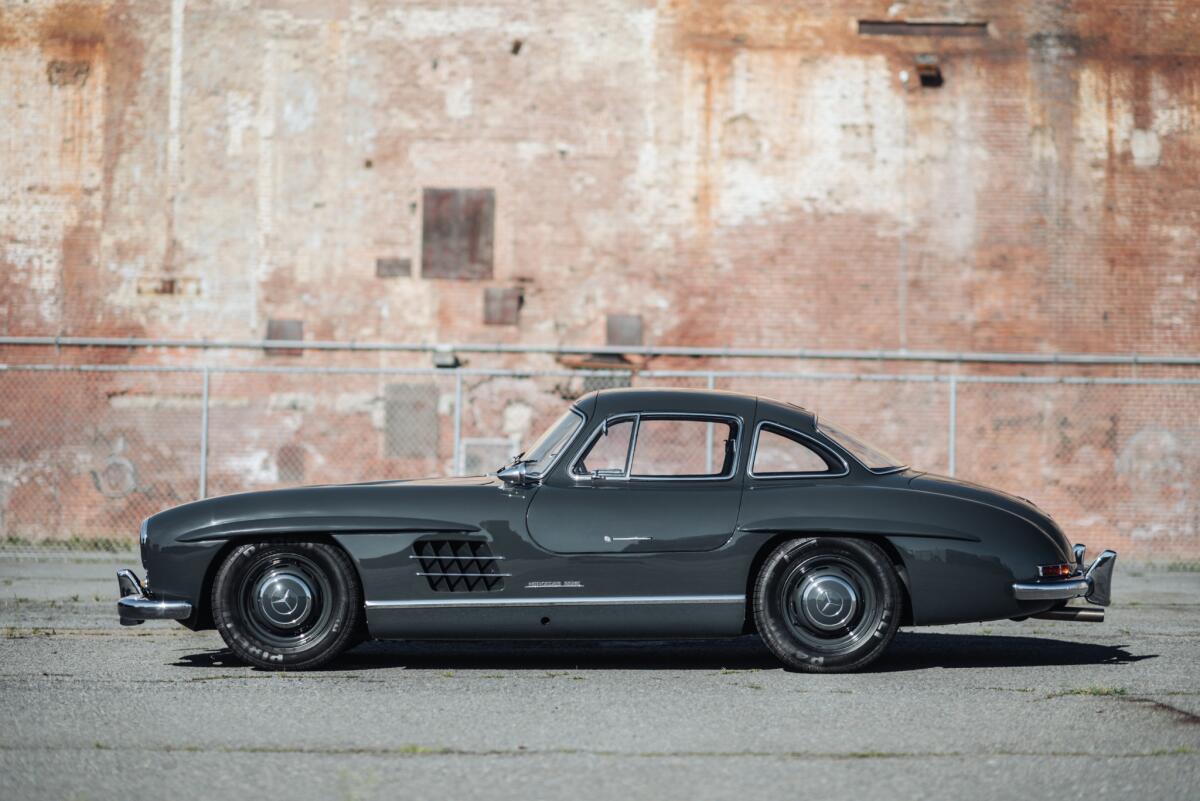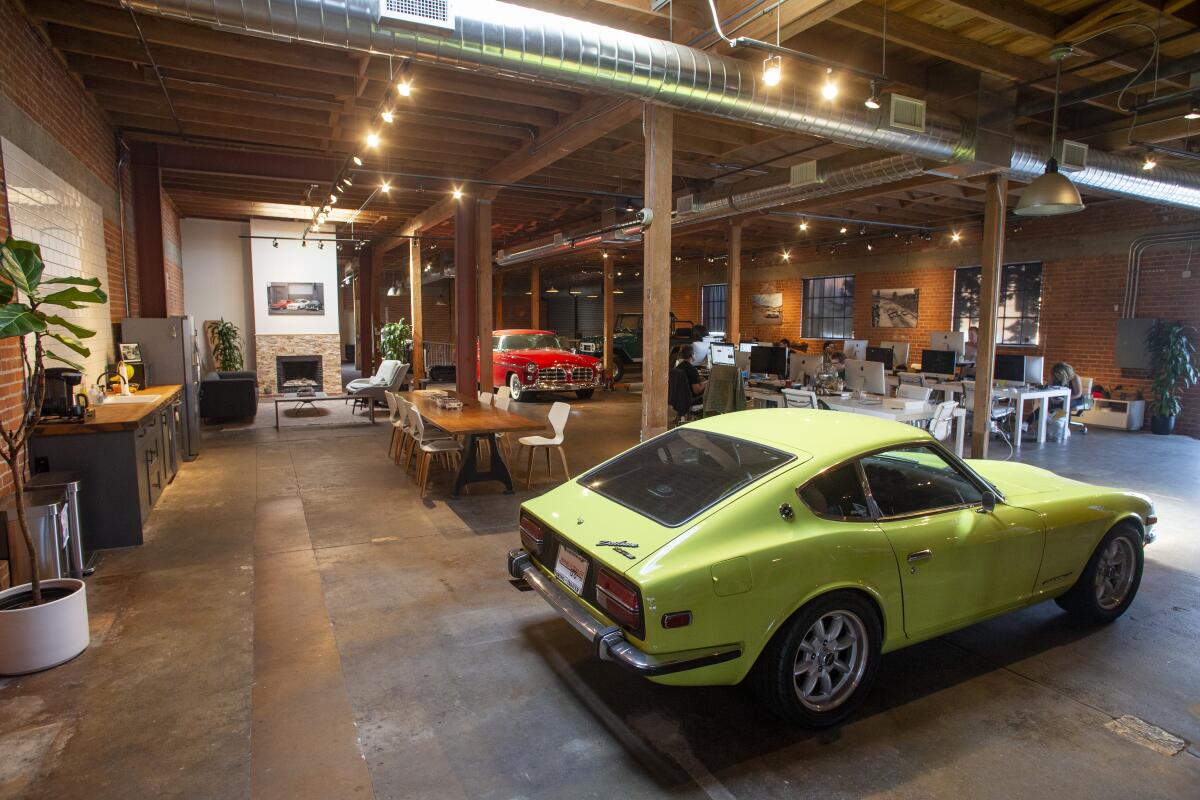Driven: For collectors of classic used cars, Bring a Trailer is a market disruptor

“When I was little, I used to love to read the classified ads in Autoweek,” says Randy Nonnenberg, the Bring a Trailer cofounder and chief executive, his bright blue eyes flashing at the memory. “I’d even cut some of them out and pin them to my wall.”
Recently, I visited Nonnenberg, a bona fide car nut (as well as an engineer and entrepreneur), and his team of 18 in their open-plan, sheet metal-filled offices in San Francisco. The company’s winning formula is auctioning collectible cars online in real time, 50-plus a day, five days a week.
The daily lineup, hand-honed by Howard Swig, head of auctions, and his team, never fails to find the delicate balance between variety, rarity and nostalgia. The mix is often actually weird, and usually weirdly successful. Cars with clean histories, fanboy followings and delectable stories rise to the top. “We look at each submission from a buyer’s perspective: What important model-specific details would a prospective bidder need to see about a specific vehicle to make an educated decision to buy?” says Swig. “We also want to list cars (and trucks and motorcycles) across a spectrum of condition and price. Every day it’s a choice between quality and quantity.”
Up until now, if you wanted to buy a Chevy Corvair, say, or a Datsun 240Z or a mint-condition, air-cooled Porsche 911, you’d go to eBay Motors, Craigslist, Hemmings, dealer sites or one of the live auction houses — from Russo and Steele and Barrett-Jackson to higher-end concerns like RM Sotheby’s. The collective online offerings from these sources are vast but leave the average buyer needing to go elsewhere to research. Live auctions pose their own limitations: They allow buyers to get up close to the cars, but the sales events happen only a few times a year, so it’s hit or miss, depending on what you’re looking for. They also tend to be more expensive — for buyer and seller.
Bring a Trailer quietly stepped into the online auction space in 2014 with three auctions a week (it now offers 275). In a few short years, the startup has successfully disrupted a crowded space with a solution no one had thought they needed — and that others want to copy.
Part of BaT’s secret sauce is the quirky daily model mix, which loyalists consume as if it were breaking news. Another ingredient is the level of service the company provides to each seller. It is exceedingly careful about the cars it accepts; Swig gives the nod to only 40-50% of vehicles submitted. Once a car passes muster, the seller is assigned a specialist/writer who captures all available information about a vehicle. The specialist tracks the sale once it’s live, jumping in to answer questions and comments over the auction’s seven days.
Moreover, unlike its competitors, BaT is a living repository for all information it’s ever posted about a car. You can see, for free, the prices the vehicle you want has commanded in past sales on BaT. (If you really want to, you can click all the way back to Nonnenberg’s first post in 2007 about an Austin-Healey he found on Craigslist.) BaT is fully transparent about all costs associated with selling and buying — an important component of the trust it has garnered from some of the industry’s most knowledgeable automotive experts.
That rabid tribe of aficionados, the third component of what sets BaT apart, is an ever-growing pack: 130,000 registered bidders and 195,000 subscribers to the daily email newsletter. Those numbers, according to Nonnenberg, are growing by 10,000-plus new users a month.

That engaged audience is neither random nor unintelligent about the cars for sale. In other words, these aren’t people with too much time on their hands. They are seasoned owners, buyers, dealers, mechanics and loyalists who have come to realize that BaT is a site of such authenticity, transparency and well, geeky attention to detail that they will take their time to weigh in and ensure the record is honest and straight.
A recent example: The suspension on an early BMW M3 caught the attention of more than a few Bimmer-philes, who questioned whether the components were stock. Dozens of comments from experts and former and current owners, all of whom had carefully inspected every photo, posed questions, teased out answers and created the human equivalent of a Carfax report — but better. “We recently listed a 1997 Acura Integra Type R with 6,000 original miles and got over 700 comments,” Nonnenberg says.
Among BaT’s fans are many automotive heavy-hitters. “The thing I like about Bring a Trailer is that it’s not extremely high end, it’s just cars of interest,” says car collector and former “Tonight Show” host Jay Leno. “I bought my 1963 Ford Falcon Sprint through them, and it saved me time. What makes it fun are finding cars with stories and without creepy people coming to your house.”
Other automotive insiders agree. “The world perceives that Bring a Trailer is not greedy; they are one of us,” says Keith Martin, founder of Sports Car Market. “They are enthusiasts at heart and that makes everyone happy.”
McKeel Hagerty, chief executive of Hagerty, a specialty provider of classic-car insurance — the Mark Zuckerberg of collector cars, according to one insider — agrees. “I give the Bring a Trailer team full credit. They are the best, safest transaction platform that we have today. Their community values truth, and that’s reflected in the prices.”
If your garage isn’t pining for a ’72 BMW 2002tii or a late ’60s Shelby Mustang, you can still get in on the addictive action. BaT has begun to work with nonprofits like L.A.’s Petersen Automotive Museum to sell experiences. It recently auctioned off the chance to get a ride in Steve McQueen’s 1956 Jaguar XKSS — one of the crown jewels of the museum’s collection.
The Petersen gave me the chance to experience what the winning bidder spent $7,500 on: I slipped into the Jag’s left-side passenger seat early one recent morning and was amazed at how visceral every detail was. Even going 30 mph through L.A. traffic was a deliciously low-slung, noisy, fume-filled joyride. And if you do bid on such a rare-air moment, the funds all go to charity.
Here is BaT’s math: Sellers pay a flat $99 fee for an approved listing, which includes guidelines on required photos and vehicle history, the written listing itself (which the owner gets to approve), and live comment tracking for the auction’s duration. For $349, BaT will send a professional photographer to capture your car’s best angles. And recently BaT launched a white-glove listing service, typically for six-figure-plus vehicles.
The cost to the seller is up to $2,000 for a turnkey marketing experience. These new, premium sales tend to run on average 14 days instead of seven. “We have found that the bigger-ticket items benefit from a longer time frame,” says Nonnenberg.
On the buyer’s side, BaT charges a flat 5% fee of the sale price, capped at $5,000. As a comparison, most live-auction houses charge up to 12%.
How successful are all these auctions? BaT’s sell-through rate is 76% , and the average price is $30,000. “We typically don’t relist cars that didn’t sell, but we do introduce the seller to the highest bidder,” says Nonnenberg. “And we don’t take any additional fees if they reach a deal.”
I asked numerous industry leaders whether BaT’s growth and success make the company ripe for acquisition. Off the record, most concurred. One even said that several smart groups in the space are trying to figure out how to build a competitive platform.
I asked Nonnenberg too about BaT’s future. He acknowledged that it has had several interested potential buyers, but so far he’s not taking the bait. True to the deeply enthusiast nature of the brand he’s built, he’s not looking for an epic windfall — a good thing, since the high-touch nature of BaT isn’t easy to scale.
“Unlike friends of mine who have started companies to eventually sell them, I am doing exactly what I really love to do,” said Nonnenberg. “And I don’t want to do anything else.”
More to Read
Sign up for our L.A. Times Plants newsletter
At the start of each month, get a roundup of upcoming plant-related activities and events in Southern California, along with links to tips and articles you may have missed.
You may occasionally receive promotional content from the Los Angeles Times.






